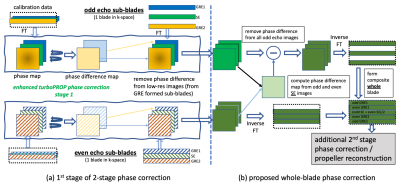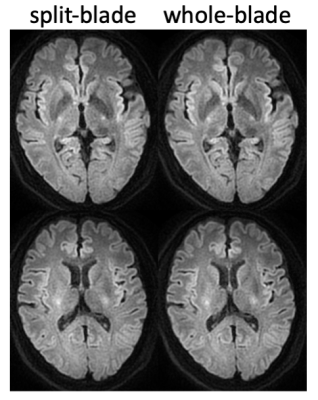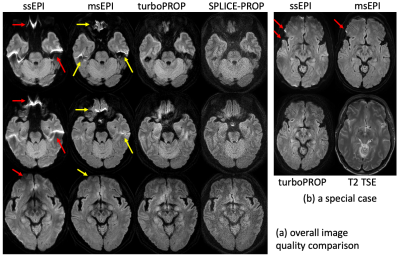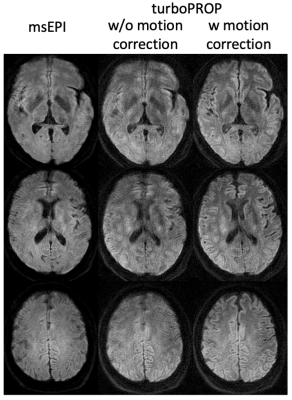0841
A whole-blade turboPROP technique with motion correction for rapid and robust DWI
Zhiqiang Li1, Melvyn B Ooi2, and John P Karis1
1Neuroradiology, Barrow Neurological Institute, Phoenix, AZ, United States, 2Philips Healthcare, Gainesville, FL, United States
1Neuroradiology, Barrow Neurological Institute, Phoenix, AZ, United States, 2Philips Healthcare, Gainesville, FL, United States
Synopsis
DW-MRI is an invaluable technique for the diagnosis of neurological disorders. ssEPI is time efficient but suffers from geometric distortions. DW-PROPELLER and its variants, including turboPROP, have been proposed for generating distortion-free images. This project proposes a new whole-blade acquisition mode with phase correction in reconstruction to increase the blade width and consequently reduce the scan time by a factor of ~2, relative to the original turboPROP. Furthermore, the increased blade width allows for robust motion correction, which was typically not performed in PROPELLER-based DWI. In vivo results demonstrate advantages over ssEPI, and recently released product msEPI and SPLICE-PROPELLER.
Introduction
Diffusion-weighted imaging (DWI) plays a critical role in clinical neuro MRI. Single-shot EPI (ssEPI) is the preferred method due to its high scan efficiency. However, ssEPI suffers from severe geometric distortion artifacts due to phase errors arising from field inhomogeneities and tissue susceptibilities. Multi-shot EPI (msEPI)1-4 helps reduce the artifacts by using a shorter echo train that results in less phase errors, though these benefits are limited in areas with strong field variations; msEPI may also be prone to motion artifacts. Turbo-spin-echo-based DW-PROPELLER5 is free from distortion artifacts, but typically has low scan efficiency. A hybrid technique, turboPROP6, 7, has been proposed to achieve high scan efficiency, and recently has been enhanced for improved image quality8. In this work, we propose a new whole-blade acquisition mode, which not only enables 2X acceleration without the need for parallel imaging and therefore avoids the g-factor penalty, but also allows for robust motion correction. This technique was compared with split-blade turboPROP8, ssEPI, and two recently released product, msEPI (IRIS)4 and SPLICE-PROPELLER9,10.Methods
In the recently improved turboPROP, odd and even echoes are placed in separate blades (split-blade) to avoid interference from phase differences due to quadratic phase modulation8. These two blades are collected at the same blade angle, equivalent to 2 signal averages, resulting in longer scan time. One way to speed up the scan is collecting these blades at orthogonal blade angles6. However, the implementation may be highly dependent on a specific scanner’s hardware platform.To overcome this issue, this work presents a new strategy that places all echoes from each shot in the same blade and corrects for the different phases in reconstruction. As shown in Figure 1, with the new k-space arrangement, the odd and even spin-echo (SE) formed sub-blades are placed in the center of k-space. Odd and even gradient-echo (GRE) formed sub-blades are placed in an interleaving fashion in the rest of k-space. The image reconstruction pipeline is shown in Figure 2. In Fig. 2a, phase differences in the GREs are first corrected separately for odd and even echoes. In Fig. 2b, phase differences between odd and even echoes are then corrected. The final result is a whole blade with enforced phase consistency across all echoes. Compared to previous split-blade mode, this whole-blade mode increases the blade width and consequently reduces the scan time by a factor of ~2, without the g-factor penalty associated with parallel imaging.
In conventional DW-PROP or turboPROP, motion correction is typically not performed, primarily due to the narrow blades that may degrade motion correction robustness. The larger blade width enabled by the whole-blade acquisition allows for robust motion correction of DW data. In this work, we propose a two-step retrospective correction strategy: PROPELLER motion correction for each diffusion image (each direction), followed by rigid-body image registration (ITK)11 between different diffusion images.
The sequence was implemented on a Philips 3T Ingenia scanner with a 15-channel phased-array coil. The whole-blade turboPROP technique was compared to recently improved split-blade turboPROP8, conventional ssEPI, and two recently released product sequences (msEPI (IRIS)4 and SPLICE-PROPELLER9). Data were collected with the following protocol: FOV=230x230 mm2, resolution=1.25x1.25 mm2, slice thickness=4 mm, gap=1 mm, 24 slices, ETL=12, GRASE factor=5, b=1000 s/mm2 at 3 directions. Scan times for ssEPI, msEPI, whole-blade turboPROP, and SPLICE PROPELLER are 0:50, 2:48, 2:47, 2:30, respectively. In the experiment comparing whole- and split-blade acquisition, both were scanned in ~5:00. A volunteer with a metallic surgical patch near the temporal lobe was scanned to evaluate distortion artifacts in the vicinity of metal. In one scan, the volunteer was instructed to perform reproducible head motions in order to evaluate motion correction capabilities.
Results and Discussion
The proposed whole-blade turboPROP is compared with previous split-blade mode in Figure 3. The image quality is comparable, proving the feasibility of the whole-blade mode that can be 2 times faster without parallel imaging.Figure 4(a) demonstrates the overall image quality of whole-blade turboPROP compared with ssEPI, msEPI (IRIS), SPLICE-PROPELLER. The strong distortion artifacts in ssEPI are reduced in msEPI but residuals are still present. The distortion artifacts are minimized in turboPROP and SPLICE-PROPELLER. The SNR of turboPROP is better than SPLICE-PROPELLER and close to msEPI. Figure 4(b) shows the case with a metallic surgical patch. The patch causes signal pileup in ssEPI, which is reduced but still observable in msEPI. These artifacts are not seen in turboPROP.
The motion correction capability of turboPROP is illustrated in Figure 5. msEPI (IRIS) is able to only remove subtle phase errors, such as due to physiological motion. Whole-blade turboprop with its wider blades allows robust rigid-body motion correction to be applied, with motion corrected results showing significantly reduced artifact in the presence of head motion.
Conclusion
In this project we propose a whole-blade turboPROP technique that achieves high scan efficiency (higher SNR and/or faster speed) compared to SPLICE-PROPELLER, reduced distortion artifacts and improved motion correction capability compared to ssEPI/msEPI, and SNR that is comparable to (but slightly lower than) msEPI. Whole-blade turboprop therefore provides a rapid and robust solution for neurological DWI applications, and is a competitive alternative to current commercially available options.Acknowledgements
No acknowledgement found.References
- Holdsworth SJ, Skare S, Newbould RD, Guzmann R, Blevins NH, Bammer R. Readout-segmented EPI for rapid high resolution diffusion imaging at 3T. Eur J Radiol. 2008;65:36-46. PMCID: PMC3360876
- Porter DA, Heidemann RM. High resolution diffusion-weighted imaging using readout-segmented echo-planar imaging, parallel imaging and a two-dimensional navigator-based reacquisition. Magn Reson Med. 2009;62:468-475.
- Chen N-k, Guidon A, Chang H-C, Song AW. A robust multi-shot scan strategy for high-resolution diffusion weighted MRI enabled by multiplexed sensitivity-encoding (MUSE). Neuroimage. 2013;72:41-47. PMCID: PMC3602151
- Jeong H-K, Gore JC, Anderson AW. High-resolution human diffusion tensor imaging using 2-D navigated multishot SENSE EPI at 7 T. Magn Reson Med. 2013;69:793-802. PMCID: PMC3424313
- Pipe JG, Farthing VG, Forbes KP. Multishot diffusion-weighted FSE using PROPELLER MRI. Magn Reson Med. 2002;47:42-52.
- Pipe JG, Zwart N. Turboprop: Improved PROPELLER imaging. Magn Reson Med. 2006;55:380-385.
- Lee C-Y, Li Z, Pipe JG, Debbins JP. Turboprop+: Enhanced turboprop diffusion-weighted imaging with a new phase correction. Magn Reson Med. 2013;70:497-503.
- Li Z, Ooi MB, Karis, JP. An enhanced turboPROP+ technique for diffusion weighted imaging. In Proceedings of the ISMRM Virtual Conference and Exhibition, 2020:p966.
- Deng J, Omary RA, Larson AC. Multishot diffusion-weighted SPLICE PROPELLER MRI of the abdomen. Magn Reson Med. 2008;59:947-953.
- Zhao X, Li Z, Gaddipati A. PROPELLER DUO: Applied to diffusion-weighted imaging. In Proceedings of the 17th ISMRM Annual Meeting, Honolulu, Hawaii, USA. 2009:p3518.
- ITK (Integrated Segmentation and Registration Kit). https://itk.org. Accessed on Dec 12, 2020.
Figures

Fig. 1. Diagram of the whole-blade turboPROP sequence (a) and corresponding k-space scheme (c). Unlike the split-blade mode (b) that places odd (solid color) and even (striped color) echoes into separate blades but at the same blade angle, the whole-blade mode (c) places odd and even echoes in the same k-space. The odd and even SE formed sub-blades are collected at the center of k-space, which also serve as calibration data. The odd and even GRE formed sub-blades are placed in an interleaving fashion to cover the rest of k-space.

Fig. 2. Recon pipeline of whole-blade turboPROP. After correction of phase errors in GRE (1st stage of previous proposed 2-stage phase correction) (a), the whole-blade phase correction is performed (b). First, the phase difference maps between odd and even SE images are computed. This is possible because odd and even SE are both collected at the center of k-space. Then these phase differences are removed from all odd GRE and SE. Following inverse FT, all (old and even, GRE and SE) sub-blades are combined to form a final whole blade in k-space, which then undergoes regular PROPELLER recon.

Fig. 3. Comparison of split-blade and whole-blade modes. Comparable image quality is observed, while the whole-blade mode can be 2 times faster.

Fig. 4. (a) compares overall image quality of 4 techniques and (b) shows a special case in the presence of metal. In (a), ssEPI shows strong signal pileup, which is reduced but still present in msEPI. Signal pileup is minimized in turboPROP (with slight signal drop off) and SPLICE-PROPELLER. SNR of turboPROP is much better than SPLICE-PROPELLER, while slightly lower than but still close to msEPI. (b) shows images from a volunteer with a surgical patch that causes signal pile up in ssEPI and msEPI, which is not visible in turboPROP. T2 TSE is acquired as reference

Fig. 5. Capability of motion correction with turboPROP. Image quality of both msEPI (left column) and turboPROP (middle column) are degraded by rigid body motion. With motion correction (including both PROPELLER motion correction of each source image and image registration between diffusion directions), the motion artifacts can be minimized (right column, same raw data as the middle column).